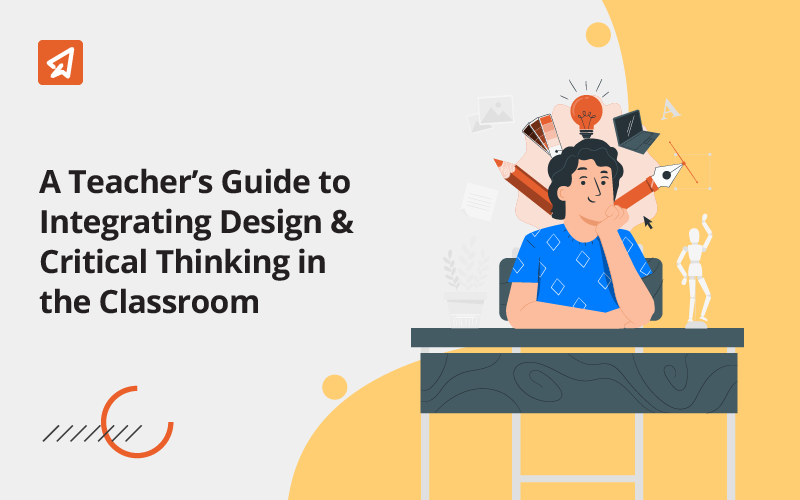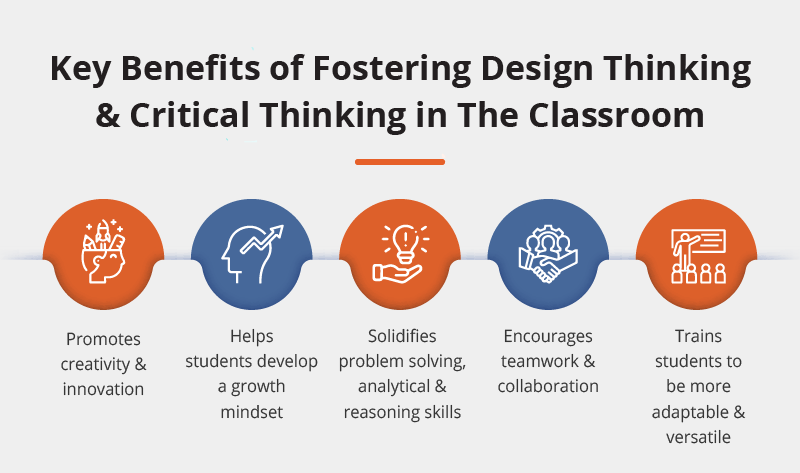A Teacher’s Guide to Integrating Design & Critical Thinking in the Classroom

As a teacher, are you aware of the key approaches that help foster innovative thinking in education? e Besides creative projects and brainstorming activities, it is essential for modern teachers to integrate the design thinking approach in learning and inculcate critical thinking skills in students to help them thrive in a society that’s constantly evolving. But, what are these approaches really about? To put it simply, design thinking encourages creative problem-solving, while critical thinking fosters analytical reasoning. Together, both of these approaches empower learners to think innovatively and make informed decisions.
In this blog, you will learn how to seamlessly incorporate these essential skills into the classroom environment and explore the key role they play in creating future-ready, agile thinkers.
Importance of Design & Critical Thinking in Modern Education
Design thinking and critical thinking are both valuable tools for helping students develop the ability to think divergently, indulge in creative ideation and become ardent problem-solvers. From using their knowledge to crack simple challenges to coming up with innovative solutions to complex problems, developing these higher-order thinking skills enable new-age learners to thrive in the real world.
To help you understand why these two key approaches are critical in today’s rapidly evolving educational landscape, let’s take a look at the importance of design and critical thinking in education and how they improve the teaching-learning experience.
#Enhanced Creative Problem-Solving Skills
Fostering design thinking encourages students to approach challenges with a creative mindset. Through emphasizing on the five stages of the design thinking process – empathizing with user’s needs, defining the problem, creating ideas, generating prototypes of the ideas and testing those solutions, students learn to tackle real-world problems with innovative problem-solving techniques. Moreover, becoming a critical thinker encourages students to evaluate and develop solutions by analyzing and learning from diverse perspectives.
#Promote Self-Assertion & Self-Reflection
Critical thinking skills help students reflect and understand different points of views in an objective manner. It enables them to make sense of the world based on personal observation, knowledge and understanding. Similarly, design thinking involves generating creative ideas and solutions to real-world issues, which empowers students to reflect on their opinions and come up with feasible solutions. This instills a sense of confidence and assurance in their abilities, which is a key necessity for 21st century learners.
#Enhanced Interdisciplinary Learning
Both design and critical thinking encourage students to draw from varied fields of knowledge and enable them to integrate diverse perspectives. By merging different disciplines and perspectives, students develop a holistic understanding of multifaceted issues and become more competent to devise comprehensive solutions. It helps them develop an adaptable mindset and come up with innovative solutions to complex problems.
#Become Future-Ready
Rapid technological advancements and global challenges are key aspects of the 21st century that students have to be prepared for. Design and critical thinking equip students with the resilience, understanding and adaptability that is needed to thrive in such a fast-paced environment. It teaches students to embrace change, reflect on their decisions, develop an innovative mindset and continuously improve their problem-solving skills. These skills are not only essential for a successful professional life but also ensure active lifelong learning.
The 5-Step Approach to Integrating Design Thinking in Education

The concept of design thinking may sound complicated, but at its core, it is essentially a systematic approach to solve problems. What sets it apart from other methodologies is that it focuses on the user and enables devising creative solutions around their needs. This approach is applicable across diverse fields, education being one of them. It improves learning, fosters creativity and drives students to develop an innovative mindset.
Let’s understand the practical implementation of design thinking in a classroom setting with the help of the five-step design thinking model.
#Step 1: Empathize
The first step is to understand the end-user’s needs, challenges and perspectives before designing solutions. In an education setting, teachers must encourage students to use research tools and conduct polls, surveys or indulge in one-on-one conversations with users to build empathy and gain insights on their viewpoints. This human-centered approach helps students connect with real-world problems.
#Step 2: Define
The second step is to gather insights from the empathize stage and define the problem they aim to solve. By clearly articulating the problem in a clear and concise manner, students can narrow down their focus and define the problem statement.
#Step 3: Ideate
The next step is where students put on their creative thinking hats and engage in brainstorming sessions to generate a wide range of ideas and potential solutions. This creative ideation process may involve self-reflection, mind maps, word associations or even group discussions to devise the optimal solution.
#Step 4: Prototype
In the following step, students create visual aids like models, flowcharts, storyboards, etc., also known as prototypes, as a tangible representation of their solution. This step encourages students to learn from their mistakes, refine their ideas, if necessary, and iterate on other solutions.
#Step 5: Test
The final step is where students test their prototypes with end users or a group of peers and gather feedback. This iterative process helps students refine their solutions and ensure that the problem has been identified effectively.
Teaching Strategies to Promote Critical Thinking in Students
Critical thinking is a key skill that students will need and use well beyond their school years. It empowers them to reflect, question and understand diverse points of views based on personal observation and understanding. Moreover, it enables them to comprehend a situation, analyze facts, think creatively and solve problems by drawing the right conclusions. It strengthens their introspective skills, problem-solving skills and decision-making skills, by instilling confidence to make choices based on their understanding.
Here are some effective teaching strategies to help students hone their critical thinking skills:
1. Practice Metacognitive Reflection
Metacognitive reflection essentially teaches students to think about their thinking. It involves self-awareness, analyzing thought patterns and reflecting on their answers. For instance, students may ask themselves ‘why do I think this is the best answer? What information do I have that supports this thought?’ This refines their thought process, enhances their critical thinking abilities and makes them adaptable learners.
2. Ask Open-Ended Questions
Practice asking questions that prompt students to analyze, evaluate and reflect on the given question. This can involve opinion-based questions like ‘what are your thoughts on the chapter that we learned today’ or ‘can you think of real-world examples of what we covered today?’ This promotes a culture of inquiry where diverse opinions can be shared, discussed and reflected upon.
3. Teach Reasoning Skills
This is a key component of critical thinking that encourages students to think logically, analyze assumptions and solve problems. Teachers can do this by presenting students with real-world scenarios and urge them to use reasoning skills to come up with feasible solutions. This forces students to apply their knowledge, think critically, evaluate diverse perspectives and devise creative solutions.
Common Activities for Implementing Design Thinking & Critical Thinking in the Classroom
Innovation has become a critical aspect of modern education. New developments in technology, educational practices and pedagogies are keeping both learners and instructors on their toes. The primary goal is to elevate the teaching-learning experience and this is where both design thinking and critical thinking play a crucial role.
Design thinking focuses on generating human-centered solutions to challenges by encouraging students to think out of the box. Critical thinking involves analyzing and evaluating data to solve problems effectively. It encourages students to question assumptions, examine evidence and objectively analyze the problem in order to make informed decisions. By integrating these key aspects into education, teachers can help students develop empathy, problem-solving skills and creativity, which are fundamental for tackling challenges.
So, how can you, as a teacher, foster design thinking and critical thinking in the classroom? Here are four practical classroom practices to help you get started:
1. Incorporate Project-Based Learning (PBL)
PBL is a student-centered instructional approach that engages students and allows them to apply their knowledge and skills to meaningful tasks. Teachers can introduce PBL in the classroom by:
– Assigning projects that involve identifying and solving challenges practically
– Encouraging students to ideate and come up with innovative solutions
– Build critical thinking skills by evaluating the feasibility of these solutions
Example: In a Geometry class, students can be asked to construct a scale model of a monument like the Taj Mahal. This will not only test their geometric principles but help them hone their creative and spatial reasoning skills.
2. Cross-Disciplinary Approach
This dynamic approach involves getting students to work on projects or assignments that require them to draw from various subjects and put their understanding of design and critical thinking into action.
-Teachers create opportunities for students to have a multi-faceted approach to learning
-Students learn how to evaluate diverse perspectives and use their knowledge to develop innovative solutions
Example: In History class, students can take up a project analyzing a specific historical event from multiple perspectives and create a multimedia presentation on their understanding. This brings together aspects of history and technology, helping students creatively and critically explore both.
3. Introduce Design Challenges
Design challenges are structured activities where students are involved in generating, prototyping and testing ideas for solving a specific problem. Here’s how to implement it in a classroom setting:
– Present students with real-world challenges that require creative solutions
– Encourage them to empathize with users, define problems, ideate solutions, create prototypes and evaluate their effectiveness through critical thinking
Example: Ask students to create an app that solves a specific real-world problem or design a website explaining a process or product.
4. Organize Debates & Discussions
Conducting discussions on complex topics can be a great way to boost both design thinking and critical thinking skills. Here’s how:
– It encourages students to carefully consider different perspectives and arguments
– Requires them to critically evaluate viewpoints and gather evidence to support defending arguments. This activity tests both critical and design thinking skills.
Example: Conduct an in-house debate session on topics like ‘should schools prioritize digital textbooks over traditional learning material for a sustainable future?’
Design and critical thinking are crucial aspects for new-age teachers as it empowers them to meet the diverse needs of 21st-century learners. Moreover, it helps them adapt to changing classroom dynamics and prepare students to thrive in a rapidly evolving world. Having a powerful digital solution can help teachers achieve this with ease.
Extramarks Smart Class Plus is a dynamic platform that offers integrated learning technologies and tech-powered tools to elevate the teaching-learning experience. Teachers can use these cutting-edge edtech tools and collaborative features like game-based modules, digital whiteboards, power questions and AI-enabled assessments to foster critical and design thinking skills in students.
For instance, the active learning feature brings self-reflection and interactive feedback together where students are prompted with questions on completing a chapter to assess their understanding in real-time. They are only guided to the next chapter if they answer correctly. This powerful platform is a great choice for enabling active and interactive learning and fostering students with the right creative and analytical skill sets. Check out the Smart Class Plus platform now!
If you’d like to learn more about cultivating these powerful higher-order thinking skills, check out the Extramarks Elevate webinar on ‘Teaching for The Future: The Synergy of Critical & Design Thinking in Digital Pedagogy’ to get a deeper insight into these transformative approaches.
Through a commitment to implementing design thinking and critical thinking practices into their instructional practice, teachers help shape a future where students are not just knowledgeable but also have the necessary skill sets to drive positive change and foster innovation in their fields of work. They empower students to become lifelong learners and adaptable problem solvers who are well-prepared to navigate the complexities of real-world challenges.
Last Updated on February 17, 2025
Reviewed by

Prachi Singh | VP - Academics
Prachi Singh is a highly accomplished educationist with over 16 years of experience in the EdTech industry. Currently, she plays a pivotal role at Extramarks, leading content strategy and curriculum development initiatives that shape the future of education...read more.









